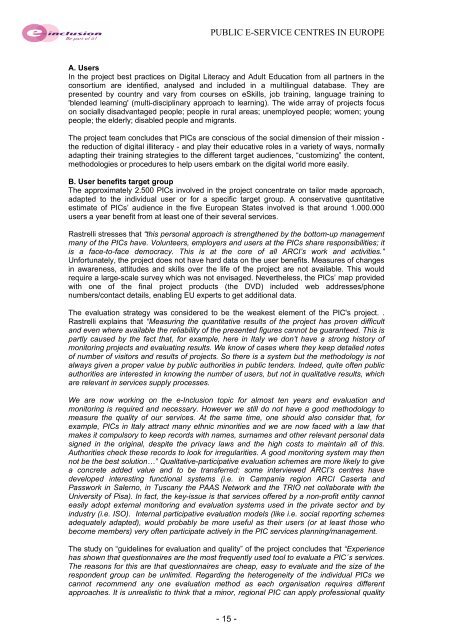Comparative Study of Public e-Service Centres in - ePractice.eu
Comparative Study of Public e-Service Centres in - ePractice.eu
Comparative Study of Public e-Service Centres in - ePractice.eu
Create successful ePaper yourself
Turn your PDF publications into a flip-book with our unique Google optimized e-Paper software.
PUBLIC E-SERVICE CENTRES IN EUROPE<br />
A. Users<br />
In the project best practices on Digital Literacy and Adult Education from all partners <strong>in</strong> the<br />
consortium are identified, analysed and <strong>in</strong>cluded <strong>in</strong> a multil<strong>in</strong>gual database. They are<br />
presented by country and vary from courses on eSkills, job tra<strong>in</strong><strong>in</strong>g, language tra<strong>in</strong><strong>in</strong>g to<br />
'blended learn<strong>in</strong>g' (multi-discipl<strong>in</strong>ary approach to learn<strong>in</strong>g). The wide array <strong>of</strong> projects focus<br />
on socially disadvantaged people; people <strong>in</strong> rural areas; unemployed people; women; young<br />
people; the elderly; disabled people and migrants.<br />
The project team concludes that PICs are conscious <strong>of</strong> the social dimension <strong>of</strong> their mission -<br />
the reduction <strong>of</strong> digital illiteracy - and play their educative roles <strong>in</strong> a variety <strong>of</strong> ways, normally<br />
adapt<strong>in</strong>g their tra<strong>in</strong><strong>in</strong>g strategies to the different target audiences, “customiz<strong>in</strong>g” the content,<br />
methodologies or procedures to help users embark on the digital world more easily.<br />
B. User benefits target group<br />
The approximately 2.500 PICs <strong>in</strong>volved <strong>in</strong> the project concentrate on tailor made approach,<br />
adapted to the <strong>in</strong>dividual user or for a specific target group. A conservative quantitative<br />
estimate <strong>of</strong> PICs’ audience <strong>in</strong> the five European States <strong>in</strong>volved is that around 1.000.000<br />
users a year benefit from at least one <strong>of</strong> their several services.<br />
Rastrelli stresses that “this personal approach is strengthened by the bottom-up management<br />
many <strong>of</strong> the PICs have. Volunteers, employers and users at the PICs share responsibilities; it<br />
is a face-to-face democracy. This is at the core <strong>of</strong> all ARCI’s work and activities.”<br />
Unfortunately, the project does not have hard data on the user benefits. Measures <strong>of</strong> changes<br />
<strong>in</strong> awareness, attitudes and skills over the life <strong>of</strong> the project are not available. This would<br />
require a large-scale survey which was not envisaged. Nevertheless, the PICs’ map provided<br />
with one <strong>of</strong> the f<strong>in</strong>al project products (the DVD) <strong>in</strong>cluded web addresses/phone<br />
numbers/contact details, enabl<strong>in</strong>g EU experts to get additional data.<br />
The evaluation strategy was considered to be the weakest element <strong>of</strong> the PIC's project. .<br />
Rastrelli expla<strong>in</strong>s that “Measur<strong>in</strong>g the quantitative results <strong>of</strong> the project has proven difficult<br />
and even where available the reliability <strong>of</strong> the presented figures cannot be guaranteed. This is<br />
partly caused by the fact that, for example, here <strong>in</strong> Italy we don’t have a strong history <strong>of</strong><br />
monitor<strong>in</strong>g projects and evaluat<strong>in</strong>g results. We know <strong>of</strong> cases where they keep detailed notes<br />
<strong>of</strong> number <strong>of</strong> visitors and results <strong>of</strong> projects. So there is a system but the methodology is not<br />
always given a proper value by public authorities <strong>in</strong> public tenders. Indeed, quite <strong>of</strong>ten public<br />
authorities are <strong>in</strong>terested <strong>in</strong> know<strong>in</strong>g the number <strong>of</strong> users, but not <strong>in</strong> qualitative results, which<br />
are relevant <strong>in</strong> services supply processes.<br />
We are now work<strong>in</strong>g on the e-Inclusion topic for almost ten years and evaluation and<br />
monitor<strong>in</strong>g is required and necessary. However we still do not have a good methodology to<br />
measure the quality <strong>of</strong> our services. At the same time, one should also consider that, for<br />
example, PICs <strong>in</strong> Italy attract many ethnic m<strong>in</strong>orities and we are now faced with a law that<br />
makes it compulsory to keep records with names, surnames and other relevant personal data<br />
signed <strong>in</strong> the orig<strong>in</strong>al, despite the privacy laws and the high costs to ma<strong>in</strong>ta<strong>in</strong> all <strong>of</strong> this.<br />
Authorities check these records to look for irregularities. A good monitor<strong>in</strong>g system may then<br />
not be the best solution…” Qualitative-participative evaluation schemes are more likely to give<br />
a concrete added value and to be transferred: some <strong>in</strong>terviewed ARCI’s centres have<br />
developed <strong>in</strong>terest<strong>in</strong>g functional systems (i.e. <strong>in</strong> Campania region ARCI Caserta and<br />
Passwork <strong>in</strong> Salerno, <strong>in</strong> Tuscany the PAAS Network and the TRIO net collaborate with the<br />
University <strong>of</strong> Pisa). In fact, the key-issue is that services <strong>of</strong>fered by a non-pr<strong>of</strong>it entity cannot<br />
easily adopt external monitor<strong>in</strong>g and evaluation systems used <strong>in</strong> the private sector and by<br />
<strong>in</strong>dustry (i.e. ISO). Internal participative evaluation models (like i.e. social report<strong>in</strong>g schemes<br />
adequately adapted), would probably be more useful as their users (or at least those who<br />
become members) very <strong>of</strong>ten participate actively <strong>in</strong> the PIC services plann<strong>in</strong>g/management.<br />
The study on “guidel<strong>in</strong>es for evaluation and quality” <strong>of</strong> the project concludes that “Experience<br />
has shown that questionnaires are the most frequently used tool to evaluate a PIC´s services.<br />
The reasons for this are that questionnaires are cheap, easy to evaluate and the size <strong>of</strong> the<br />
respondent group can be unlimited. Regard<strong>in</strong>g the heterogeneity <strong>of</strong> the <strong>in</strong>dividual PICs we<br />
cannot recommend any one evaluation method as each organisation requires different<br />
approaches. It is unrealistic to th<strong>in</strong>k that a m<strong>in</strong>or, regional PIC can apply pr<strong>of</strong>essional quality<br />
- 15 -
















